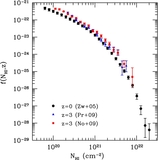On the Origin of the High Column Density Turnover in the H I Column Density Distribution
Abstract
We study the high column density regime of the H I column density distribution function and argue that there are two distinct features: a turnover at N H I ≈ 1021 cm-2, which is present at both z = 0 and z ≈ 3, and a lack of systems above N H I ≈ 1022 cm-2 at z = 0. Using observations of the column density distribution, we argue that the H I-H2 transition does not cause the turnover at N H I ≈ 1021 cm-2 but can plausibly explain the turnover at N H I >~ 1022 cm-2. We compute the H I column density distribution of individual galaxies in the THINGS sample and show that the turnover column density depends only weakly on metallicity. Furthermore, we show that the column density distribution of galaxies, corrected for inclination, is insensitive to the resolution of the H I map or to averaging in radial shells. Our results indicate that the similarity of H I column density distributions at z = 3 and 0 is due to the similarity of the maximum H I surface densities of high-z and low-z disks, set presumably by universal processes that shape properties of the gaseous disks of galaxies. Using fully cosmological simulations, we explore other candidate physical mechanisms that could produce a turnover in the column density distribution. We show that while turbulence within giant molecular clouds cannot affect the damped Lyα column density distribution, stellar feedback can affect it significantly if the feedback is sufficiently effective in removing gas from the central 2-3 kpc of high-redshift galaxies. Finally, we argue that it is meaningful to compare column densities averaged over ~ kpc scales with those estimated from quasar spectra that probe sub-pc scales due to the steep power spectrum of H I column density fluctuations observed in nearby galaxies.
- Publication:
-
The Astrophysical Journal
- Pub Date:
- December 2012
- DOI:
- 10.1088/0004-637X/761/1/54
- arXiv:
- arXiv:1201.3653
- Bibcode:
- 2012ApJ...761...54E
- Keywords:
-
- galaxies: formation;
- galaxies: ISM;
- methods: data analysis;
- methods: numerical;
- quasars: absorption lines;
- Astrophysics - Cosmology and Nongalactic Astrophysics;
- Astrophysics - Astrophysics of Galaxies
- E-Print:
- Accepted to ApJ. Updated to version in journal
